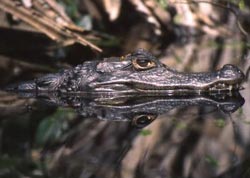Yellow peril: Are banana farms contaminating Costa Rica''s crocs?

This is a photo of a spectacled caiman (Caiman crocodilus). Credit: Paul Grant<br>
New research, published in Environmental Toxicology and Chemistry, analyses blood samples from spectacled caiman in Costa Rica and finds that intensive pesticide use in plantations leads to contaminated species in protected conservation areas.
“Banana plantations are big business in Costa Rica, which exports an estimated 1.8 million tonnes per year; 10% of the global total,” said author Paul Grant from Stellenbosch University, South Africa. “The climate of the country's North East is ideal for bananas; however, the Rio Suerte, which flows through this major banana producing area, drains into the Tortuguero Conservation Area.”
Tortuguero is home to the spectacled caiman (Caiman crocodilus), one of the most common species of crocodilian in Central America. This freshwater predator is known to be highly adaptive, feeding on fish, crustaceans and in the case of larger specimens, wild pigs.
Due to the increased global demand for fruit, pesticide use has more than doubled across Central America in the past twenty years. In Costa Rica, which ranks second in the world for intensity of pesticide use, the problem of contamination is compounded by environmental conditions and lax enforcement of regulations.
“Frequent heavy rains can wash pesticides from plantation areas, leading to contamination and the reapplication of sprays to the crops,” said Grant. “Without adequate enforcement of regulations dangerous practices such as aerial spraying close to streams or washing application equipment in rivers also contributes to contamination downstream.”
The team collected blood samples from 14 adult caiman and analyzed them for traces of 70 types of pesticide. Caiman within the high intensity banana crop watershed of Rio Suerte had higher pesticide burdens relative to other more remote locations.
The nine pesticides detected in the caiman blood were identified as insecticides. Of these seven were listed as Persistent Organic Pollutants (POPS), banned under the 2011 Stockholm Convention.
“Caiman near banana plantations had higher pesticide burdens and lower body condition,” said Grant. “This suggests that either pesticides pose a health risk to caiman, or that pesticides harm the habitat and food supply of caiman, thereby reducing the health of this predator.”
As long-lived species atop the food chain crocodilians provide an integrated assessment of the fate of pesticides in tropical areas and can be indicative of pesticide damage throughout the ecosystem.
“Caiman and other aquatic species have been exposed to pesticides from upstream banana plantations, even in remote areas of a national wilderness area,” concluded Grant. “Banana plantations may be economically important to Costa Rica; however their erosion of aquatic ecosystems highlights the need for a developed regulatory infrastructure and adequate enforcement.”
Media Contact
More Information:
http://www.wiley.comAll latest news from the category: Ecology, The Environment and Conservation
This complex theme deals primarily with interactions between organisms and the environmental factors that impact them, but to a greater extent between individual inanimate environmental factors.
innovations-report offers informative reports and articles on topics such as climate protection, landscape conservation, ecological systems, wildlife and nature parks and ecosystem efficiency and balance.
Newest articles

Properties of new materials for microchips
… can now be measured well. Reseachers of Delft University of Technology demonstrated measuring performance properties of ultrathin silicon membranes. Making ever smaller and more powerful chips requires new ultrathin…

Floating solar’s potential
… to support sustainable development by addressing climate, water, and energy goals holistically. A new study published this week in Nature Energy raises the potential for floating solar photovoltaics (FPV)…

Skyrmions move at record speeds
… a step towards the computing of the future. An international research team led by scientists from the CNRS1 has discovered that the magnetic nanobubbles2 known as skyrmions can be…





















